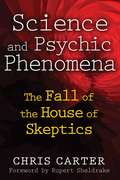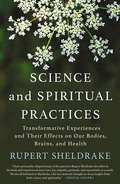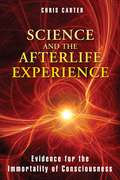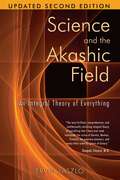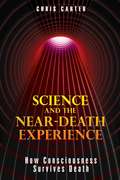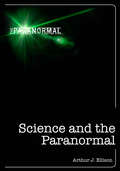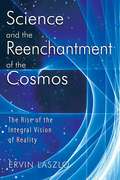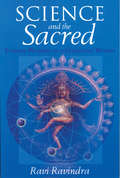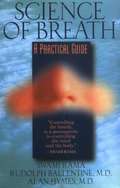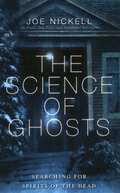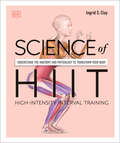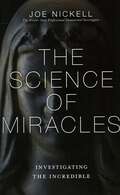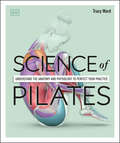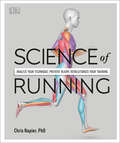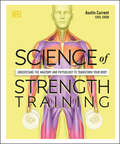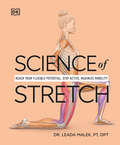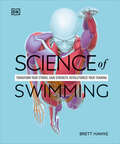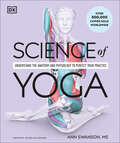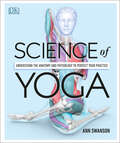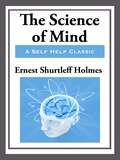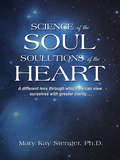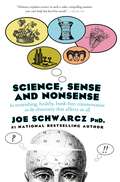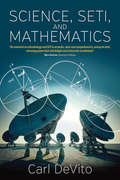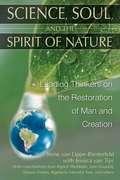- Table View
- List View
Science and Psychic Phenomena: The Fall of the House of Skeptics
by Rupert Sheldrake Chris CarterA factual and conscientious argument against materialism’s vehement denial of psi phenomena • Explores the scandalous history of parapsychology since the scientific revolution of the 17th century • Provides reproducible evidence from scientific research that telepathy, clairvoyance, precognition, and psychokinesis are real • Shows that skepticism of psi phenomena is based more on a religion of materialism than on hard science Reports of psychic abilities, such as telepathy, clairvoyance, precognition, and psychokinesis, date back to the beginning of recorded human history in all cultures. Documented, reproducible evidence exists that these abilities are real, yet the mainstream scientific community has vehemently denied the existence of psi phenomena for centuries. The battle over the reality of psi has carried on in scientific academies, courtrooms, scholarly journals, newspapers, and radio stations and has included scandals, wild accusations, ruined reputations, as well as bizarre characters on both sides of the debate. If true evidence exists, why then is the study of psi phenomena--parapsychology--so controversial? And why has the controversy lasted for centuries? Exploring the scandalous history of parapsychology and citing decades of research, Chris Carter shows that, contrary to mainstream belief, replicable evidence of psi phenomena exists. The controversy over parapsychology continues not because ESP and other abilities cannot be verified but because their existence challenges deeply held worldviews more strongly rooted in religious and philosophical beliefs than in hard science. Carter reveals how the doctrine of materialism--in which nothing matters but matter--has become an infallible article of faith for many scientists and philosophers, much like the convictions of religious fundamentalists. Consequently, the possibility of psychic abilities cannot be tolerated because their existence would refute materialism and contradict a deeply ingrained ideology. By outlining the origin of this passionate debate, Carter calls on all open-minded individuals to disregard the church of skepticism and reach their own conclusions by looking at the vast body of evidence.
Science and Spiritual Practices: Transformative Experiences and Their Effects on Our Bodies, Brains, and Health
by Rupert Sheldrake"I have personally adopted many of the practices Rupert describes in his book and experienced more love, joy, empathy, gratitude, and equanimity as a result. We are all indebted to Rupert, who has tirelessly brought us deep insights from both science and spirituality.&” ―Deepak ChopraThe effects of spiritual practices are now being investigated scientifically as never before, and many studies have shown that religious and spiritual practices generally make people happier and healthier. In this pioneering book, Rupert Sheldrake shows how science helps validate seven practices on which many religions are built, and which are part of our common human heritage: meditation, gratitude, connecting with nature, relating to plants, rituals, singing and chanting, and pilgrimage and holy places.Sheldrake summarizes the latest scientific research on what happens when we take part in these practices, and suggests ways that readers can explore these fields for themselves. For those who are religious, Science and Spiritual Practices will illuminate the evolutionary origins of their own traditions and give a new appreciation of their power. For the nonreligious, this book will show how the core practices of spirituality are accessible to all.This is a book for anyone who suspects that in the drive toward radical secularism, something valuable has been left behind. Rupert Sheldrake compellingly argues that by opening ourselves to the spiritual dimension, we may find the strength to live more fulfilling lives.
Science and the Afterlife Experience: Evidence for the Immortality of Consciousness
by Chris CarterReveals the evidence of life beyond death • Examines 125 years of scientific research into reincarnation, apparitions, and communication with the dead showing these phenomena are real • Reveals the existence of higher planes of consciousness where the souls of the dead can choose to advance or manifest once again on Earth • Explains how these findings have been ignored and denied because they are incompatible with materialist doctrines In this book, Chris Carter shows that evidence of life beyond death exists and has been around for millennia, predating any organized religion. Focusing on three key phenomena--reincarnation, apparitions, and communications from the dead--Carter reveals 125 years of documented scientific studies by independent researchers and the British and American Societies for Psychical Research that rule out hoaxes, fraud, and hallucinations and prove these afterlife phenomena are real. The author examines historic and modern accounts of detailed past-life memories, visits from the deceased, and communications with the dead via medium and automatic writing as well as the scientific methods used to confirm these experiences. He explains how these findings on the afterlife have been ignored and denied because they are incompatible with the prevailing doctrine of materialism. Sharing messages from the dead themselves describing the afterlife, Carter reveals how consciousness exists outside the parameters of biological evolution and emerges through the medium of the brain to use the physical world as a springboard for growth. After death, souls can advance to higher planes of consciousness or manifest once again on Earth. Carter’s rigorous argument proves--beyond any reasonable doubt--not only that consciousness survives death and continues in the afterlife, but that it precedes birth as well.
Science and the Akashic Field: An Integral Theory of Everything
by Ervin LaszloPresents the unifying world-concept long sought by scientists, mystics, and sages: an Integral Theory of Everything • Explains how modern science has rediscovered the Akashic Field of perennial philosophy • New edition updates ongoing scientific studies, presents new research inspired by the first edition, and includes new case studies and a section on animal telepathy Mystics and sages have long maintained that there exists an interconnecting cosmic field at the roots of reality that conserves and conveys information, a field known as the Akashic record. Recent discoveries in vacuum physics show that this Akashic Field is real and has its equivalent in science’s zero-point field that underlies space itself. This field consists of a subtle sea of fluctuating energies from which all things arise: atoms and galaxies, stars and planets, living beings, and even consciousness. This zero-point Akashic Field is the constant and enduring memory of the universe. It holds the record of all that has happened on Earth and in the cosmos and relates it to all that is yet to happen. In Science and the Akashic Field, philosopher and scientist Ervin Laszlo conveys the essential element of this information field in language that is accessible and clear. From the world of science he confirms our deepest intuitions of the oneness of creation in the Integral Theory of Everything. We discover that, as philosopher William James stated, “We are like islands in the sea, separate on the surface but connected in the deep.”
Science and the Near-Death Experience: How Consciousness Survives Death
by Chris CarterThe scientific evidence for life after death • Explains why near-death experiences (NDEs) offer evidence of an afterlife and discredits the psychological and physiological explanations for them • Challenges materialist arguments against consciousness surviving death • Examines ancient and modern accounts of NDEs from around the world, including China, India, and many from tribal societies such as the Native American and the Maori Predating all organized religion, the belief in an afterlife is fundamental to the human experience and dates back at least to the Neanderthals. By the mid-19th century, however, spurred by the progress of science, many people began to question the existence of an afterlife, and the doctrine of materialism--which believes that consciousness is a creation of the brain--began to spread. Now, using scientific evidence, Chris Carter challenges materialist arguments against consciousness surviving death and shows how near-death experiences (NDEs) may truly provide a glimpse of an awaiting afterlife. Using evidence from scientific studies, quantum mechanics, and consciousness research, Carter reveals how consciousness does not depend on the brain and may, in fact, survive the death of our bodies. Examining ancient and modern accounts of NDEs from around the world, including China, India, and tribal societies such as the Native American and the Maori, he explains how NDEs provide evidence of consciousness surviving the death of our bodies. He looks at the many psychological and physiological explanations for NDEs raised by skeptics--such as stress, birth memories, or oxygen starvation--and clearly shows why each of them fails to truly explain the NDE. Exploring the similarities between NDEs and visions experienced during actual death and the intersection of physics and consciousness, Carter uncovers the truth about mind, matter, and life after death.
Science and the Paranormal (The Paranormal)
by Arthur J. EllisonThe Paranormal, the new ebook series from F+W Media International Ltd, resurrecting rare titles, classic publications and out-of-print texts, as well as new ebook titles on the supernatural - other-worldly books for the digital age. The series includes a range of paranormal subjects from angels, fairies and UFOs to near-death experiences, vampires, ghosts and witchcraft. In facts, not fiction, this book presents the case for the paranormal. Changing the way we look at the universe is not easy, and requires a true openness to exploration and experiment. Professor Ellison suggests that most of us are conditioned by our Western science-based education to think that the universe is much simpler and 'material' than it really is. He argues that we should recognize the limits of the current scientific worldview which fails to account for genuine paranormal experiences, including phenomena such as out-of-body experiences (OBE), reliably reported by thousands of people.
Science and the Reenchantment of the Cosmos: The Rise of the Integral Vision of Reality
by Ervin LaszloPresents a revolutionary new theory that bridges the divide between science and spirituality• Discloses the ramifications of non-localized consciousness and how the physical world and spiritual experience are two aspects of the same reality• Includes contributions from Jane Goodall, Ed Mitchell, Stanislav Grof, Ralph Abraham, and Christian de Quincy, among othersWhat scientists are now finding at the outermost frontiers of every field is overturning all the basic premises concerning the nature of matter and reality. The universe is not a world of separate things and events but is a cosmos that is connected, coherent, and bears a profound resemblance to the visions held in the earliest spiritual traditions in which the physical world and spiritual experience were both aspects of the same reality and man and the universe were one. The findings that justify this new vision of the underlying logic of the universe come from almost all of the empirical sciences: physics, cosmology, the life sciences, and consciousness research. They explain how interactions lead to interconnections that produce instantaneous and multifaceted coherence--what happens to one part also happens to the other parts, and hence to the system as a whole. The sense of sacred oneness experienced by our ancestors that was displaced by the unyielding material presumptions of modern science can be restored, and humanity can once again feel at home in the universe.
Science and the Sacred
by Ravi RavindraEinstein said the best scientists have always approached science as a sacred activity that could yield "the secrets of the Old One," Ravi Ravindra points out. This eloquent book at once affirms scientific exploration and addresses the failure of science to deal with the inner life.We all want to know why things happen and how we can control certain outcomes; but we also rightly wonder about meaning and purpose: Does the earth need people? What about me personally? What is my place? Why am I here?Coming from the East, this Western physicist offers a rare hybrid view on such topics as:-Perception in yoga and physics-The moral responsibility of scientific power-Science as a spiritual path-Healing the soul: truth, love, and God"Each of us is an artist of our own life," Ravindra says. "Starting from the raw material of our self, we sculpt something which corresponds to our aspirations, our understanding, our skill and sensitivity...This work of transformation is an imperative of our human existence."
Science and the Sacred
by Ravi RavindraEinstein said the best scientists have always approached science as a sacred activity that could yield "the secrets of the Old One," Ravi Ravindra points out. This eloquent book at once affirms scientific exploration and addresses the failure of science to deal with the inner life. We all want to know why things happen and how we can control certain outcomes; but we also rightly wonder about meaning and purpose: Does the earth need people? What about me personally? What is my place? Why am I here? Coming from the East, this Western physicist offers a rare hybrid view on such topics as: Perception in yoga and physics; The moral responsibility of scientific power; Science as a spiritual path; Healing the soul: truth, love, and God. "Each of us is an artist of our own life," Ravindra says. "Starting from the raw material of our self, we sculpt something which corresponds to our aspirations, our understanding, our skill and sensitivity...This work of transformation is an imperative of our human existence."
Science of Breath: A Practical Guide
by Swami Rama Rudolph Ballentine Alan HymesMuch of the Western world was completely unaware of the profound impact of the breath on the body and mind until the 1970's. It was during this time that Swami Rama astonished physiologists by demonstrating perfect control over his heart rate and brain waves―something Western scientists didn't believe humans could possibly achieve. In this book, Swami Rama shares some of the basic breathing techniques practiced by Himalayan yogis, so that you too can experience the profound effects of pranayama and breath control. <p><p> The goal of Science of Breath is to present knowledge and practices regarding the breath in a way that can be applied to personal growth. This book is a masterful guide to systematically identifying bad breathing habits, replacing those habits with healthy breathing patterns, and developing control over pranic flow. Learn how to develop and master the link between your body and mind through the understanding of the breath. With increased awareness and control of the subtle aspects of breathing, one can effect deep physical and psychological changes and begin to master the roaming tendencies of the mind. Science of Breath opens the door to a new way of being, providing a powerful tool in the pursuit of holistic health and personal growth.
Science of Ghosts: Searching for Spirits of the Dead
by Joe NickellAre ghosts real? Are there truly haunted places, only haunted people, or both? And how can we know? Taking neither a credulous nor a dismissive approach, this first-of-its-kind book solves those perplexing mysteries and more—even answering the question of why we care so very much. Putting aside purely romantic tales, this book examines the actual evidence for ghosts—from eyewitness accounts to mediumistic productions (such as diaphanous forms materializing in dim light), spirit photographs, ghost-detection phenomena, and even CSI-type trace evidence. Offering numerous exciting case studies, this book engages in serious investigation rather than breathless mystifying. Pseudoscience, folk legends, and outright hoaxes are challenged and exposed, while the historical, cultural, and scientific aspects of ghost experiences and haunting reports are carefully explored. The author—the world's only professional paranormal investigator—brings his skills as a stage magician, private detective, folklorist, and forensic science writer to bear on a topic that demands serious study.
Science of HIIT: Understand the Anatomy and Physiology to Transform Your Body
by Ingrid S. ClayTrain your way to a leaner, stronger body in half the time or less!Get ready to break a serious sweat with this scientific guide to HIIT training! Discover everything you need to know to achieve the best results from your HIIT workouts by understanding the muscle action needed to perfect each exercise.Inside the pages of this fitness book, you&’ll explore the physiology of more than 90 essential HIIT exercises! It is packed with: • Specially commissioned CGI artworks depicting all the main HIIT resistance exercises — from burpees to plank jacks — and variations that add or reduce the challenge. • CGI artwork features color-coding to highlight how the muscles, ligaments and joints engage, stretch and relax to perform each exercise. • Training programs, tailored to different abilities and goals, provide suggested workouts with a progressive increase in challenges over weeks and months. • Easy-to-follow infographics help explain the hard science behind why HIIT training is so efficient, and what beneficial physical adaptations it can bring. High-intensity interval training is a fantastic way to lose weight and get strong by performing very short bursts of targeted exercise. Recent scientific research shows that HIIT is the most efficient form of exercise for raising fitness levels and increasing cardio-respiratory health. Science of HIIT reveals the facts to help you optimize the benefits of HITT to your body and mind.The clear CGI artwork details the mechanics of each exercise, correct body posture, the muscles involved and how they engage to perform movements. You&’ll also learn the knowledge and tools needed to be able to create your own bespoke workouts. This HIIT guide will completely transform your performance and help you smash your goals!DK Publishing&’s Science of series helps readers discover the research and scientific theories behind exercise and sport. It&’s perfect for training at home or the gym. Other sport science books in this series include Science of Yoga and Science of Strength Training.
Science of Miracles: Investigating the Incredible
by Joe NickellAn entertaining, comprehensive, and science-based study of miracle claims Is the Shroud of Turin really the burial cloth of Jesus, produced by a miraculous burst of radiant energy at the moment of Resurrection? What happens at faith-healing services to provide apparently miraculous cures? Steering between the twin pillars of belief and disbelief, experienced paranormal investigator Joe Nickell examines these claims and more. Relying on his forty-plus years of experience in tracking down the solutions to mysteries, Nickell uses on-site examinations, lab experiments, and other detective methods to uncover the facts behind the most incredible claims. He evaluates the evidence in six major categories of miracle claims: miraculous images (such as "weeping" icons); magical relics (like the Shroud of Turin and the Holy Grail); miracle healings (at Lourdes or at the hands of healers like Benny Hinn); visionary experiences (including near-death experiences); saintly powers (such as stigmata); and "the devil's work" (such as demonic possession). Conveying the sense of adventure surrounding the investigation of any mystery, this is both entertaining reading and a comprehensive, science-based study of miracle claims.
Science of Pilates: Understand the Anatomy and Physiology to Perfect Your Practice (DK Science of)
by Tracy WardExplore the science behind over 50 pilates exercises to master each movement with confidence and control. DK brings you a ground-breaking health book that will help you revitalize your workouts and perfect your Pilates practice, by understanding the muscle action, breathwork and techniques required, every step of the way. Did you know that performing Pilates can strengthen your core, improve flexibility and posture, and help to reduce stress and anxiety at the same time? Backed by scientific research, learn how Pilates exercises benefit every system in the body. Science of Pilates reveals the facts with annotated artworks that show the mechanics, the angles, how your blood flow and respiration are affected, the key muscle and joint actions working below the surface of each exercise, safe alignment, and much more!Go on a journey of self-discovery to explore: - Specially commissioned CGI artworks depict all the main Pilates exercises with variations that add or reduce challenge. - Artworks detail the mechanics of each exercise, correct body posture, the muscles involved and how they engage to perform movements.- Illustrations featuring color-coding to highlight how the muscles, ligaments, and joints engage, stretch, and relax to perform each exercise.- Pilates programs tailored to different abilities and aims.- Suggested practices with a progressive increase in challenge over weeks and months.- Easy-to-follow infographics help explain the hard science behind why Pilates training is so effective and what beneficial physical adaptations it can bring.Set out to unearth the facts behind the pseudo-science fads, The Science of Pilates is an approachable, entertaining and easy-to read fitness guide for those seeking self-development backed up by solid scientific evidence. The popular question and answer format brings immediacy to the information provided, and the highly visually illustrations truly bring the science to life in a contemporary and accessible way. At DK, we believe in the power of discovery. So why stop there? If you like Science of Pilates, then why not try Science of Yoga to help you better understand yoga anatomy in order to perfect your practice and poses, or Science of Strength Training to support you in your journey to build you strongest body. Complete the collection today!
Science of Running: Analyse your Technique, Prevent Injury, Revolutionize your Training
by Chris NapierRevolutionize your running techniques! Learn how to run better and faster, with more energy while avoiding injury. There is a science to running, and now you can learn about it too! Whether you are new to running, or have conquered a few marathons in your time, this runner's guide will show you how to train efficiently, find a suitable running regime, and master the art of running for life!Inside the pages of this running book, you&’ll find:- Explanations on the anatomy and physiology of the runner.- Easy-to-read descriptions of how running involves every system in the body.- A scientific breakdown of what happens under the skin at every stage of the running cycle.- Featuring anatomy of common injuries and exercise programs for both prevention and recovery.- 30 key exercises and how to perfect precision to optimize their benefits.- Bespoke training plans for runners at all levels.Expert-led insights backed by scientific research will show you how to start running, how to run faster, and how to improve your flexibility and gait for running efficiency and safety. Included in the Science of Running are exercises and training programs that target each muscle to ensure you become a stronger, better runner. The clear CGI images show annotations to muscle mechanics so you know you are taking the right steps and perfecting technique. Learn the science behind your body&’s energy systems, proper hydration and nutrition. From long-distance to marathon running, this sports book will completely transform your performance of injury-free running and help you to smash your goals one step at a time, proving the ideal running gift for the fitness fanatic in your life. At DK, we believe in the power of discovery. So why not dive deeper into our successful Science of series, where you can discover the research and scientific theories behind exercise and sport. Explore the anatomy of yoga to perfect your practice in Science of Yoga; or redefine your daily routine with Science of Living.
Science of Strength Training: Understand the anatomy and physiology to transform your body
by Austin CurrentIs it time to lose weight, gain muscle, and speed up your metabolism? Discover the hard science needed to perfect each exercise and build your strongest body – at home or in the gymPacked with research that supports the notion that bodyweight exercises help you reach your weight and fitness goals, this simple to follow guide also gives you valuable insight into how nutrition and exercise can improve your health.Inside the pages of this strength training book, you&’ll discover: • The physiology and benefits of strength training • Workout plans for beginners, enthusiasts, and personal trainers • The hard dietary science that debunks common myths and important information to properly fuel your body • Depictions of 33 exercises: how to do them, common mistakes, and the benefits of each Work towards your strength goalsIn this book, Author Austin Current takes readers through the science of strength training, weight loss, nutrition, and overall health. The book looks at why many people fear strength training, why they shouldn&’t, and how they can incorporate it into their daily lives. Filled with CGI artwork and science-backed information, this exercise book will help you transform your body and improve your well-being. Not only that, but this title also includes full workout plans and over 100 individual exercises. You&’ll learn how your muscles engage at each stage, how to do movements properly and without injury, and it shows you different variations for home and gym. This book is also packed with nutritional information and includes dietary advice for vegans and vegetarians. Discover more in the series DK's Science of series dives into the science of various types of exercises such as weight training, running, and yoga. Each book discusses the benefits of the specific type of workout and how you can transform your outlook about health and fitness. How The Book WorksThe first section — human physiology — introduces you to the wonder that is skeletal muscle and the mechanisms that underpin strength training&’s demands on the body. It will help you understand how muscles work and grow, and how the resistance work stimulates muscles to develop strength and size, alongside its positive impacts on bones and connective tissue. It also explains how the body powers muscular work and shows you how to calculate your own daily macronutrient requirements. Lastly, you&’re given an overview of the benefits to the brain, and the crucial role it plays in attitude and mental health.The second section — strength exercises — is devoted to a comprehensive collection of strength training exercises to perform, along with many variations offered to compliment your available training equipment, personal preferences, and level of challenge — at home or in the gym. Each exercise displays the muscles being used throughout the movement with detailed instruction on how to achieve proper form and technique; common mistakes are covered, too.The third section — preventing injury — explores common injuries related to resistance training, with explanations on how to avoid them and how to return to training if you do suffer an injury. A consistent and structured routine, including a proper warm-up, prepares the body for work, and the various mobility exercises and stretches given will help you tune in to how your body is responding to the training.The final section — how to train — outlines everything you need to know about the variables of effective strength training, such as training volume and fatigue management. Whether you want to build muscle, strength, or endurance, you&’ll find an easy-to-follow program to suit, as well as alternatives for those wanting to
Science of Stretch: Reach Your Flexible Potential, Stay Active, Maximize Mobility (DK Science of)
by Dr. Leada MalekExplore new movements and alleviate stiff joints with more than 100 exercises designed to keep you flexible, energized, and active for life. Pain and stiffness can create fear and uncertainty in our ability to move, affecting quality of life. Exercise has continuously proven to be beneficial against disease, yet people are becoming increasingly sedentary.More than a quarter of the world's population is insufficiently active and it's time we remove barriers to exercise and encourage movement exploration. The Science of Stretch is your guide to understanding the human body's resilient and adaptable nature and how stretching can play a role in achieving your highest well-being.Inside the pages of this book you'll learn about:-The latest research on stretching-Human anatomy and physiology-The nervous system and pain science-How to reduce injury risk with exercise-Managing a lifestyle catered towards healthy aging-What happens to the body when we stretch-Different types of stretching and how to implement them to best compliment your daily life or sporting activities-Finally, a series of suggested stretch routines are outlined, each with a progressive increase in challenge and tailored to different abilities and fitness objectives-alongside the tools to create your own bespoke workouts.Every exercise is anatomized in detail to make movement easily understood using CGI artworks to show how each muscle is correctly activated and each joint aligned. Whether you're taking a walk around the park or running a marathon, Science of Stretch will help you stay flexible, keep active, and remove the uncertainty from stretching.
Science of Swimming: Transform Your Stroke, Improve Strength, Revolutionize Your Training (DK Science of)
by Brett HawkeLearn the science needed to perfect your stroke, swim faster, and endure for longer.Science of Swimming dives deeper than any other book to examine the muscle groups and bodily systems involved in being an effective swimmer; how they interact with the hydrodynamics of water resistance; and how you can apply this knowledge to streamline your technique and achieve your training goals.Each swim stroke is anatomized so you can analyze and adapt your stroke to swim smarter.Full-spectrum training programs—for all abilities and goals—combine drills, speed work, and endurance with dry-land conditioning routines targeting muscle strength, flexibility, and aerobic intensity.All the latest scientific insights explained, including optimum nutrition, the importance of sleep hygiene, and techniques for mental resilience, to questions about wetsuits and open-water swimming.Whether you're swimming simply for relaxation, competing for a club, training for a distance badge or triathlon, or planning to explore the oceans, Science of Swimming will support you both in and out of the water.
Science of Yoga: Understand the Anatomy and Physiology to Perfect Your Practice (DK Science of)
by Ann SwansonExplore the biomechanics of 30 key yoga asanas, in-depth and from every angle, and master each pose with confidence and control.Introducing Science of Yoga - an all-encompassing science book to help you better understand yoga anatomy and the medical science behind yoga to perfect your practice and poses!Did you know that yoga practice can help treat age-related memory loss better than brain-training games? Recent scientific research now supports what were once anecdotal claims about the benefits of yoga to every system in the body. Science of Yoga provides a detailed insight into variations of key yoga poses and the specific benefits of different styles of yoga on the human body, system by system. Dive right in to discover: - Specially commissioned CGI artworks show 30 asanas in depth and detail the physics of the pose - 16 spreads of clear, easy-to-understand scientific facts and research answering key questions around ancient and modern claims - Illustrated section on the benefits of yoga on the human body system by system - Easy-to-understand research is presented in an easy-to-understand format with illustrated pullouts, debunking the myths and explaining the scientific facts, from breathing techniques to mindfulnessScience of Yoga is a riveting read, and reveals how your blood flow, respiration, muscles and joints work below the surface of each yoga pose, whilst teaching you to achieve technical excellence in your practice, from the comfort of your own home.The first yoga book on the market to combine detailed anatomical drawings, pose mechanics and key scientific research, Science of Yoga is a must-have volume for yoga beginners and professionals alike, seeking an accessible and easy-to-read guide on the effects of yoga on the human body from a scientific standpoint. Whether you’re looking to take up yoga this New Year, or your yoga poses are already perfect, this science book is the ideal fitness gift for the yoga lover in your life, and sets out to separate the facts of yoga from the myths, with proven scientific research.
Science of Yoga: Understand the Anatomy and Physiology to Perfect Your Practice (Dk Science Of Ser.)
by Ann SwansonExplore the biomechanics of 30 key yoga asanas, in-depth and from every angle, and master each pose with confidence and control.Introducing Science of Yoga - an all-encompassing science book to help you better understand yoga anatomy and the medical science behind yoga to perfect your practice and poses!Did you know that yoga practice can help treat age-related memory loss better than brain-training games? Recent scientific research now supports what were once anecdotal claims about the benefits of yoga to every system in the body. Science of Yoga provides a detailed insight into variations of key yoga poses and the specific benefits of different styles of yoga on the human body, system by system. Dive right in to discover: - Specially commissioned CGI artworks show 30 asanas in depth and detail the physics of the pose - 16 spreads of clear, easy-to-understand scientific facts and research answering key questions around ancient and modern claims - Illustrated section on the benefits of yoga on the human body system by system - Easy-to-understand research is presented in an easy-to-understand format with illustrated pullouts, debunking the myths and explaining the scientific facts, from breathing techniques to mindfulnessScience of Yoga is a riveting read, and reveals how your blood flow, respiration, muscles and joints work below the surface of each yoga pose, whilst teaching you to achieve technical excellence in your practice, from the comfort of your own home.The first yoga book on the market to combine detailed anatomical drawings, pose mechanics and key scientific research, Science of Yoga is a must-have volume for yoga beginners and professionals alike, seeking an accessible and easy-to-read guide on the effects of yoga on the human body from a scientific standpoint. Whether you&’re looking to take up yoga this New Year, or your yoga poses are already perfect, this science book is the ideal fitness gift for the yoga lover in your life, and sets out to separate the facts of yoga from the myths, with proven scientific research.
Science of the Mind
by Ernest Shurtleff Holmes2011 Reprint of 1926 edition. Full facsimile of the original edition, not reproduced with Optical Recognition Software. Ernest Shurtleff Holmes (1887-1960) was an American writer and spiritual teacher. He was the founder of a movement known as Religious Science, also known as "Science of Mind", a part of the New Thought movement. He was the author of The Science of Mind and numerous other metaphysical books. His books remain in print, and the principles he taught as "Science of Mind" have inspired and influenced many generations of metaphysical students and teachers. His influence beyond New Thought can be seen in the self-help movement. The Science of Mind is his most influential work. Herein is reprinted in full text the 1926 edition of Holme's The Science of Mind.
Science of the Soul: Solutions of the Heart
by Mary Kay StengerScience of the Soul explores the mystery of the mind and gives us a different lens through which we can view ourselves with greater clarity. We can now prove scientifically that none of us is alone, ever. No one has to live their life or pass to their death alone. The Science of the Soul or Spirit expands awareness of our individual Soul Path in this life and beyond. Our soul has all the answers and “soulutions” that will move us past any challenge, large or small, and any form of suffering that is currently consuming our will to have an exceptional life. In this book you will find: • Basic information about heart and soul science • Scientific evidence with carefully documented examples directly from the healing room • Demonstrations that illustrate and describe a “soul path” or “soul journey” • Questions for reflection • Tools for assistance, including Visualizations, Relaxation Exercises & Guided Meditations Writes author, Dr. Mary Kay Stenger: “Regardless of the nature of the issue that a client may bring to me, I approach and treat it at the soul or ‘source’ level. I know that once my client begins to communicate and connect with their soul, they will have all the answers they need in order to start healing themselves and creating a joy-filled life that resonates with their deepest desires. “Whether we are business executives, service providers, stay-at-home mothers, government workers, artists, athletes, students—whatever our profession and wherever we are on our life path—I believe we can benefit from an expanded perspective of who we really are by exploring the premise that the soul is our Personal Guidance System, or PGS. In this book I wish to give each of you expanded perspective, insight and excitement about this adventure called life.”
Science, Sense and Nonsense: 61 Nourishing, Healthy, Bunk-free Commentaries on the Chemistry That Affects Us All
by Joe SchwarczWhen did "chemical" become a dirty word?Forty or so years ago, chemistry -- which had been recognized as a miracle-making boon to humanity - somehow became associated with warfare, sinister food additives, "toxins" and pollution.It's a situation that Dr. Joe Schwarcz aims to put into perspective. Yes, there's a downside to chemistry, he says, but this is dwarfed by its enormous benefits.Dr. Joe's new collection of commentaries will inspire an appreciation for the science of everyday life, and equip you to spot the muddled thinking, misunderstandings and deceptions in media stories and advertising claims. Does organic food really always equal better food? Are vaccines dangerous? Will the latest health fad make you ill? Do expensive wrinkle creams do the job? What are the best ways to avoid cancer? The answers to such questions often lie in anunderstanding of the chemistry involved. Ask Dr. Joe.Science, Sense and Nonsense celebrates chemistry's great achievements, lambastes its charlatans, and explores its essential connections to our wellbeing. And does so in authoritative, highly readable, good humoured style.From the Trade Paperback edition.
Science, Seti, and Mathematics
by Carl L. DeVitoMathematics is as much a part of our humanity as music and art. And it is our mathematics that might be understandable, even familiar, to a distant race and might provide the basis for mutual communication. This book discusses, in a conversational way, the role of mathematics in the search for extraterrestrial intelligence. The author explores the science behind that search, its history, and the many questions associated with it, including those regarding the nature of language and the philosophical/psychological motivation behind this search.
Science, Soul, and the Spirit of Nature: Leading Thinkers on the Restoration of Man and Creation
by Jane Goodall Rupert Sheldrake Masaru Emoto Irene van Lippe-Biesterfeld Jessica Van Tijn Rigoberta Menchú TumAn exploration of the relationship between humans and nature through conversations with 12 leading scientific and social visionaries • Explores the importance of the unification of humankind and nature as it relates to creation, destruction, diversity, and the spiritual health of the world • Contains interviews with Rupert Sheldrake, Jane Goodall, and Nobel Peace Prize-winner Rigoberta Menchú Tum, among others Society’s attitude toward nature has changed considerably over the years. Terms pertaining to the anthropocentric paradigm of "mankind in charge," such as supervisor or owner, have been replaced by caretaker or trustee. This approach, although more appropriate, still indicates a complete separation of humankind from nature. Yet increasing numbers of people have begun to feel that they are intrinsically part of nature. This concept of unity with the natural world--that we are nature--is gaining momentum among many innovative social reformers from many diverse fields. In Science, Soul, and the Spirit of Nature, Irene van Lippe-Biesterfeld interviews 12 respected visionary thinkers, representing all continents, about their deep connection with the earth and their views on the relationship between humanity and nature. Presented as a series of thought-provoking conversations, this book delves deeply into the many conceptions we hold about nature, showing that while many strides have been made in the area of its preservation, we must now take the next step. Each contributor adds insights into the urgent change in consciousness that we must adopt in order to heal and restore our holistic relationship with the earth that was emblematic of the first peoples--reminding us that a separation from and destruction of nature is a spiritual destruction of ourselves.
